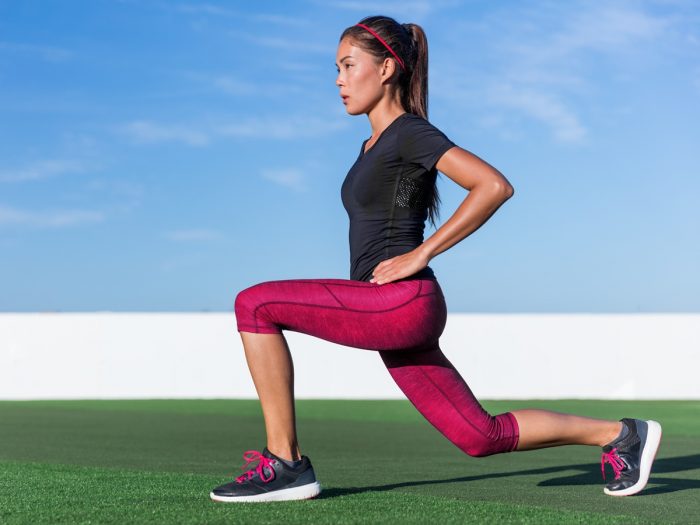Exercising the legs can be difficult, but lunges are some of the easiest and most effective ways to shape and tone various muscle groups in the legs. Quite simply, lunges are performed by taking a large step forward with one leg, keeping the foot flat on the ground, leaving the other leg behind it. This seemingly simple exercise is harder than it might initially appear but can work out various areas near the buttocks, hip, knee, calf, and thigh.
Used by everyone from cross-training athletes to yogis, this workout relies on the weight of the body to provide the resistance; lifting the weight with those targeted muscles creates the workout. Aside from strength and muscle training, there are a number of other benefits to lunges, as well as different types to incorporate into your daily workout. [1]
Benefits of Lunges
The most important benefits of lunges include increasing core strength, boosting hip flexibility, improving balance, toning your buttocks, strengthening the knees and working out your quadriceps, among others.

Make lunges part of your daily workout routine. Photo Credit: Shutterstock
Increase Core Strength
Many people choose this exercise because of the effect it has on core strength. There is a great deal of core work going on in your abdominal and your back to keep you upright and balanced while completing a lunge. The repeated use of lunge exercises will improve your posture and endurance, while also boosting abdominal strength and definition. [2]
Tone Buttocks
There is a squatting element of lunges that works out your buttocks, and the muscles beneath, known as the gluteal muscles. This increase in the muscle activity can help to burn fat and even improve your metabolism, which promotes, even more, muscle growth and fat elimination. [3]
Quadriceps Workout
These large muscles in your legs are required for countless daily activities, particularly those involved in the athletic performance. This exercise will engage both your quadriceps and hamstrings, helping to keep your legs strong and lowering your risk of injury. [4]
Maintain Balance
These exercises are perhaps most known for improving balance. The motion of a lunge is unusual for the body, and it must carefully maintain its balance, which engages muscles throughout the legs and back. [5]
Increase Hip Flexibility
Your hips move in many different directions, and yet they can also be weak points in the body. Increasing the flexibility of your hips with lunges is an excellent idea, particularly if you are an athlete. [6]
Strengthen Knees
Strengthening the muscles around the knee can be difficult, but lunges are a safe and reliable way to boost the support, flexibility, and strength of the tendons around that area of the body. [7]
Types of Lunges
The main types of lunges include the walking, static, and reverse lunges, although there are many other variations, depending on your specific strength or training goals.
Static Lunge
A static lunge consists of standing in place, with your legs in the shape of a triangle, one forward and the other back. Slowly lower your back knee until it touches the ground and then rise back to the original position. Be sure to alternate legs in this exercise. [8]
Reverse Lunge
Instead of stepping forward to perform this lunge, you will move your leg back to move into the lunge position. This will use different muscles for balance and will generate a different exercise in your quadriceps and buttocks. [9]
Walking Lunge
This is a continuous version of lunges where you walk forward, and each step is a deep lunge. This is a quick and easy exercise to do during a lunch break or on a short walk, as even 15-20 of these alternating lunges can be a good workout for your legs. [10]
Split Squat Lunge
In a split squat lunge, one of your feet will be elevated – either your back or front foot. By elevating one of these feet, it will “deepen” the exercise, causing your muscles to work harder, and requiring support for the body’s balance at different angles. [11]
How to Perform Lunges with Weight?
Many people choose to perform lunges while holding weight, as this can increase the difficulty of the exercise, and improve the muscle gains as a result. However, there are a few things to consider before doing lunges with weights. Slowly increase the weight, rather than immediately jumping in with 10-pound dumbbells. This can lower your risk of injury or muscle strain. You can use dumbbells in both or just one hand, both of which can help accentuate the workout in different ways.
What Muscles Do Dumbbell Lunges Work Out?
When you choose to perform lunges with dumbbells, you are immediately making the workout more difficult. There is an increasing impact on certain muscles, such as your hips, ankles, gluteal muscles, core and the muscles you require for running and jumping.
